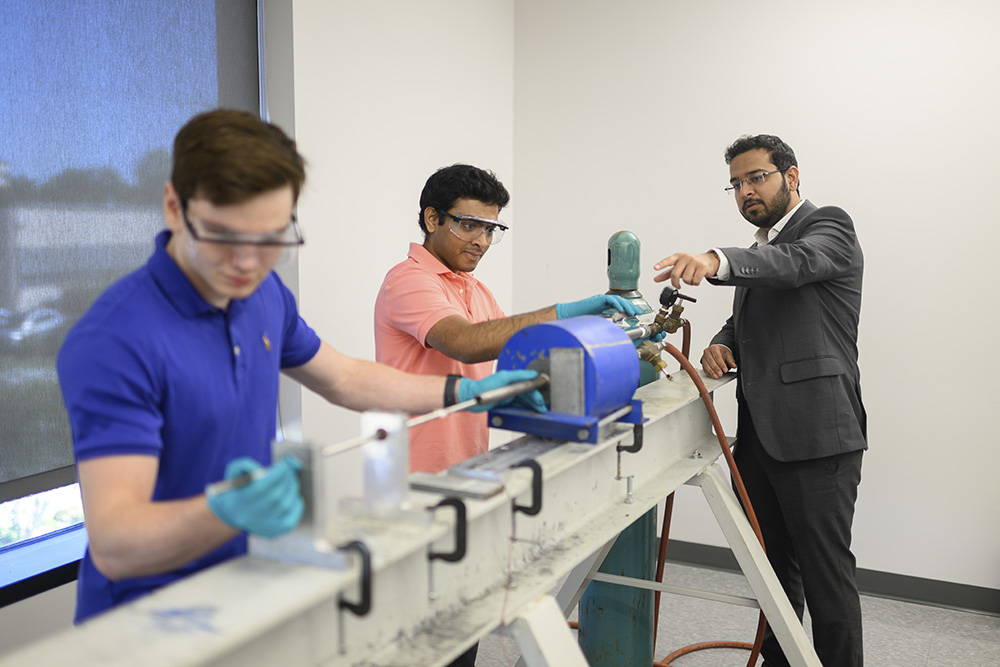LSU, Delaware and Johns Hopkins Researchers Examine the Mechanics of the Human Brain
 April 4, 2024
April 4, 2024
BATON ROUGE, LA – Faculty from LSU, the University of Delaware, and Johns Hopkins University are collaborating on a project that may help us better understand how large and rapid mechanical forces deform the brain during events such as falls and car crashes. Having this understanding is critical to developing computer models for predicting brain injury, as well as designing safer personal protective equipment and brain injury management and prevention strategies.
Led by LSU Mechanical Engineering Assistant Professor Kshitiz Upadhyay, the research team includes University of Delaware Associate Professor of Biomedical Engineering Curtis Johnson and Johns Hopkins Associate Professor of Civil and Systems Engineering Michael Shields. The trio is funded by a National Science Foundation Collaborative Research grant of $880,000.
“Loading rate refers to how fast or slow mechanical forces deform the brain during events such as falls and car crashes,” Upadhyay said. “Physical deformation (i.e., compression or tension) of brain tissue inside the skull causes traumatic brain injury or TBI (e.g, concussion). Large loading means large deformation of the brain. Larger and faster deformations (i.e., high loading rate) are deleterious to brain health and can cause TBI. In this study, we aim to understand the ‘extreme mechanics of the living human brain,’ meaning the relationship between mechanical forces and brain tissue deformation under very fast loading rates.
“The main motivation for this study is that although research suggests that brain tissue properties change after death, most modern computer models for predicting TBI are based on brain tissue properties from ex vivo (i.e., taking place outside the body) experiments, which use cadaveric brains. No one knows exactly how a living human’s brain responds to large, rapid mechanical loading. As we cannot conduct impact-loading experiments on living humans, someone had to develop an innovative method to predict the living brain’s response to such extreme, injurious conditions. This is exactly what we will do in this project, and we have devised a novel integrated experimental computational framework for this purpose.”
For the first stage of the project, Johnson’s lab at Delaware will conduct the first-ever wide-band magnetic resonance elastography (MRE) scans on human brain tissues harvested from cadavers. These experiments will uncover how the human brain responds to small but rapid loading. Previously, Johnson’s lab collected in vivo MRE scans of living humans under non-injurious conditions. Using these two datasets, ex vivo and in vivo, Upadhyay’s lab and Shields’ lab at Johns Hopkins will develop novel multi-fidelity computational models to predict the linear viscoelastic properties of living humans’ brains across a wide range of loading rates.
In the second stage of the project, Upadhyay’s lab will conduct mechanical tests on human brain tissues ex vivo, applying large deformations to study the nonlinear tissue behavior under a wide range of loading rates. Using that data, the LSU team will develop constitutive models that mathematically capture mechanical responses. It will then work with Shields’ lab to develop multi-fidelity computational models to extrapolate ex vivo data to the in vivo regime by using what was learned in the first stage of the project.
“Basically, our mechanical experiments will fill the gaps in the experimental mechanics literature for the human brain, and our machine learning-based computational models will discover the mechanical properties of the living human brain under extreme conditions of large and rapid loading,” Upadhyay explained.
Like us on Facebook (@lsuengineering) or follow us on X (formerly Twitter) and Instagram (@lsuengineering).
###
Contact: Joshua Duplechain
Director of Communications
225-578-5706
josh@lsu.edu
Latest College of Engineering News
- LSU ChE, SJA Students Study Breast Cancer in 3D EnvironmentOctober 24, 2022BATON ROUGE, LA - Though October is recognized nationally as Breast Cancer Awareness Month, LSU faculty and students are working every month to help combat the potentially fatal disease that has been projected to affect nearly 340,000 Americans this year.
- Testing Backdate
- LSU Researchers Create Low-Cost Method to Recycle PlasticBATON ROUGE – LSU researchers have created a new, low-cost way to break down plastic, a potential breakthrough that could save billions of dollars and eliminate billions of tons of plastic pollution.
- CEE's Mohammad Appointed to Editorship of ASCE PublicationBATON ROUGE, LA - LSU Civil and Environmental Engineering Professor Louay Mohammad has been selected to serve as co-editor-in-chief of the Journal of Materials in Civil Engineering (JMCE), a publication of the American Society of Civil Engineers (ASCE).
- LSU Construction Management Professor Developing Occupant-Centric Energy Management SystemBATON ROUGE, LA - Thermostat wars are not just limited to the home; they are also common in office environments and can result in negative outcomes like adversely affecting worker productivity and driving up energy costs unnecessarily.
- LSU Civil and Environmental Engineering Professor Develops Software to Protect Offshore WindfarmsIn July 2023, the U.S. Department of the Interior announced that it would hold the first-ever offshore wind energy lease sale in the Gulf of Mexico. Since then, renewable energy companies have expressed interest in wind farming, with the Bureau of Ocean Energy Management finalizing four Wind Energy Areas that could produce enough clean, renewable energy to power more than 3 million homes. However, with this rapid growth comes challenges, such as protecting these wind farms from hurricanes.






